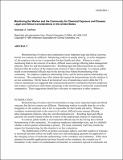| dc.description.abstract | Biomonitoring of workers and communities raises important legal and ethical concerns,
but the two contexts are different. Monitoring workers is usually done by, or at the instigation
of, the employer who in law is responsible for their health and safety. Whenever worker
monitoring leads to the removal of workers, difficult issues emerge affecting labor-management
relations, labor law and discrimination law. Resulting legal and ethical questions are usually
framed within the context of the employment contract or labor relationship. In contrast, public
health or environmental officials may be the driving force behind biomonitoring of the
community. No employer-employee relationship exists, and the doctor-patient relationship may
be tenuous. The community may often initiate the request for biomonitoring, but the situation is
no less contentious. On the basis of an historical view of monitoring events within the U.S.
context, mechanisms are suggested that would promote positive interactions between employers
and workers, and between individuals and groups in the monitoring of chemically contaminated
communities. These suggestions should have relevance to experience in other countries | en |
